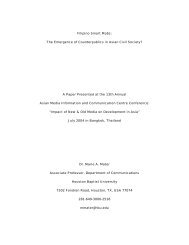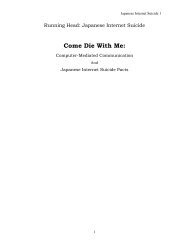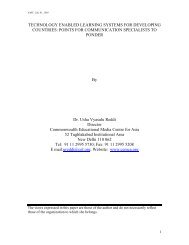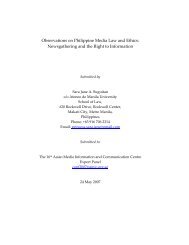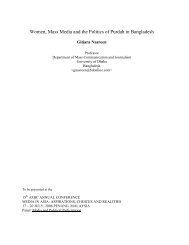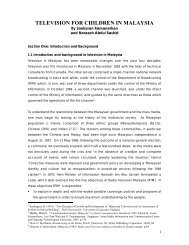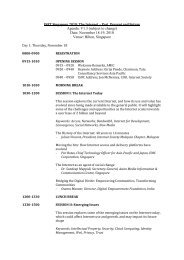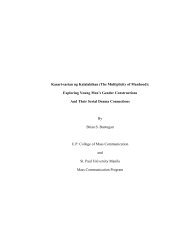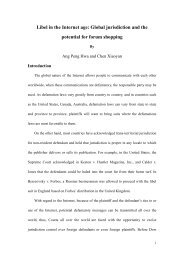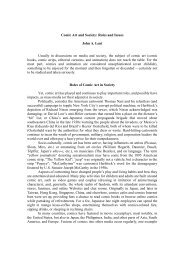Ethnicity and dissent in community media development: A ... - AMIC
Ethnicity and dissent in community media development: A ... - AMIC
Ethnicity and dissent in community media development: A ... - AMIC
You also want an ePaper? Increase the reach of your titles
YUMPU automatically turns print PDFs into web optimized ePapers that Google loves.
<strong>Ethnicity</strong> <strong>and</strong> <strong>dissent</strong> <strong>in</strong> <strong>community</strong> <strong>media</strong> <strong>development</strong>:A case study of Burmese/Myanmar <strong>media</strong>-<strong>in</strong>-exilePaper prepared for presentation atThe 15 th <strong>AMIC</strong> Annual Conference:“Media <strong>in</strong> Asia: Aspirations, Choices <strong>and</strong> Realities”To be published <strong>in</strong> the Journal of Communication Inquiry, special theme edition:Political Violence <strong>and</strong> the MediaForthcom<strong>in</strong>g, October 2006Under the title:Political Violence <strong>and</strong> Journalism <strong>in</strong> a Multi-ethnic State:A Case Study of Burma (Myanmar) 1Dr. Lisa BrootenDepartment of Radio-Television<strong>and</strong>Global Media Research CenterCollege of Mass Communication <strong>and</strong> Media ArtsSouthern Ill<strong>in</strong>ois University CarbondaleMailcode 6609Carbondale, IL 62901-6609U.S.A.Phone: work (618) 453-5896Phone: home (618) 549-9474Fax (618) 453-69821 The author would like to thank John Down<strong>in</strong>g <strong>and</strong> Rachel Malcolm-Woods as well as anonymousreviewers for their comments on earlier drafts.
Political Violence <strong>and</strong> Journalism <strong>in</strong> a Multi-ethnic State:A Case Study of Burma (Myanmar) 2Current debates about <strong>media</strong> <strong>and</strong> journalism <strong>in</strong> contexts of political violencemove between, on the one h<strong>and</strong>, arguments for “objectivity” <strong>in</strong> report<strong>in</strong>g <strong>and</strong>, on theother, conceptualizations of the journalist as a facilitator of resolution to the conflict.Should reporters <strong>in</strong> conflict situations strive to be “objective,” neutral observers or dothey “highlight the carnage <strong>in</strong> such a way that public pressure might br<strong>in</strong>g about outside<strong>in</strong>tervention?” (Botes, 1996, 2). Most contributions to this debate, however, take as agiven that the journalist is an outsider to the <strong>community</strong>, <strong>and</strong> this <strong>in</strong> an era when largesums of money are be<strong>in</strong>g devoted by aid agencies to tra<strong>in</strong><strong>in</strong>g <strong>in</strong>digenous journalists <strong>in</strong>areas of conflict <strong>in</strong> the basics of journalism <strong>and</strong> <strong>media</strong> <strong>development</strong>.By focus<strong>in</strong>g on the situation of journalists from Burma (Myanmar) liv<strong>in</strong>g <strong>in</strong> exile <strong>in</strong>Thail<strong>and</strong>, this article explores the consequences of political violence on the <strong>development</strong>of <strong>in</strong>digenous journalism <strong>in</strong> a multi-ethnic state. Draw<strong>in</strong>g on data gathered fromparticipant observation <strong>and</strong> <strong>in</strong>-depth <strong>in</strong>terviews with journalists along the border betweenThail<strong>and</strong> <strong>and</strong> Burma, the research exam<strong>in</strong>es how local journalists are struggl<strong>in</strong>g todevelop a context-appropriate model for <strong>media</strong> <strong>development</strong> that adequately addressestheir need to deal with disagreement <strong>and</strong> difference <strong>in</strong> a context of political violence. The2 The country’s name has taken on especially political connotations s<strong>in</strong>ce 1989, when the military regimechanged the name to the Union of Myanmar. While the government claimed the new name is ethnicallyneutral <strong>and</strong> promotes national unity, the opposition movement opposed the name change, made withoutconsult<strong>in</strong>g the people. ‘Burma’ has been the term preferred by the opposition. While the UN has acceptedthe name change, the U.S. government has not, <strong>and</strong> the terms have become an <strong>in</strong>dicator of one’s politicalposition <strong>in</strong> the struggle for control over the country. S<strong>in</strong>ce this paper focuses on the opposition movement,the term ‘Burma’ will be used here. The term ‘Burman’ is used to refer to the ethnic majority of thecountry, while ‘Burmese’ is used as an adjective to refer to the language <strong>and</strong> the country’s various peoples.Thus, an ethnic Karen, for example, is both Karen <strong>and</strong> one of the Burmese peoples.2
esearch calls <strong>in</strong>to question the relevance of the dom<strong>in</strong>ant US approach to “objective”journalism. In this often dangerous context, the def<strong>in</strong>ition of concepts such as “unity,”“<strong>media</strong> <strong>in</strong>dependence,” <strong>and</strong> “censorship” must be seen as provisional <strong>and</strong> contested,given the various pressures brought to bear on journalists. The model of journalismaris<strong>in</strong>g organically <strong>in</strong> this context is <strong>in</strong>fluenced by the recent surge <strong>in</strong> foreign fund<strong>in</strong>g forjournalism tra<strong>in</strong><strong>in</strong>g, yet borrows elements of both the normative, objective model <strong>and</strong> themodel of peace journalism. The <strong>in</strong>appropriate nature of imported journalistic ideologies,however, suggests the need for a more complex model of <strong>media</strong> <strong>development</strong> <strong>in</strong> suchcomplicated <strong>and</strong> conflictual contexts.Violence <strong>and</strong> <strong>Ethnicity</strong> <strong>in</strong> BurmaHome to the world’s longest-runn<strong>in</strong>g civil war, Burma is characterized by greatethnic diversity, with over one hundred different languages <strong>and</strong> dialects identified (Smith,1999). 3 Population statistics are generally unavailable, <strong>and</strong> contentious when they are,s<strong>in</strong>ce there has been no attempt to take a count of the population s<strong>in</strong>ce the British census<strong>in</strong> 1931 (Smith, 1991). The 1974 Constitution identifies seven divisions <strong>and</strong> seven ethnicstates – Ch<strong>in</strong>, Kach<strong>in</strong>, Karen, Kayah (Karenni), Mon, Rakh<strong>in</strong>e (Arakan) <strong>and</strong> Shan. Thereare several other large m<strong>in</strong>ority groups <strong>in</strong> the country, as well as many Ch<strong>in</strong>ese, Tamils,Bengalis <strong>and</strong> others of Indian orig<strong>in</strong>. The most recent figures available, from 1983, listthe majority Burmans as compris<strong>in</strong>g 69% of the population (Ste<strong>in</strong>berg, 2001).Annexed by Brita<strong>in</strong> <strong>in</strong> stages between 1824 <strong>and</strong> 1886, Burma was governed atfirst as a prov<strong>in</strong>ce of India. The British divided its adm<strong>in</strong>istration <strong>in</strong> Burma <strong>in</strong>to two3 The civil war between the Burmese government <strong>and</strong> the Karen National Union (KNU) has been ongo<strong>in</strong>gs<strong>in</strong>ce 1948.3
population, was not secured by the government (Ste<strong>in</strong>berg, 2001, p. 186). The ethnic<strong>in</strong>surgencies <strong>and</strong> the government’s counter<strong>in</strong>surgency operations have led to massivenumbers of casualties 5 <strong>and</strong> to the pattern of violence perpetuat<strong>in</strong>g longst<strong>and</strong><strong>in</strong>g distrust,especially between the Burmans <strong>and</strong> the non-Burmans, although factionalism is alsowidespread with<strong>in</strong> the Burmese opposition groups. 6Shortly after tak<strong>in</strong>g power <strong>in</strong> 1988, the SLORC began arrang<strong>in</strong>g ceasefires withethnic nationality groups, who would agree to stop fight<strong>in</strong>g <strong>in</strong> exchange for governmentpromises of more assistance with <strong>development</strong> <strong>in</strong> education, health care, transportation<strong>and</strong> <strong>in</strong>frastructure (Ste<strong>in</strong>berg, 2001). These two th<strong>in</strong>gs together – the ceasefires <strong>and</strong> theirrelationship to <strong>in</strong>frastructural <strong>development</strong> – offered the government a cloak oflegitimacy despite its status as an <strong>in</strong>ternational pariah after the bloodshed of 1988. Yetmany ethnic m<strong>in</strong>ority leaders believed, as did Hkun Okker, president of the Pa-OPeople’s Liberation Organization, that the military regime got the upper h<strong>and</strong> by mak<strong>in</strong>gdeals with groups <strong>in</strong>dividually. “The military regime cleverly recognized that the ethnicpower has a major role to play <strong>in</strong> Burmese politics, so im<strong>media</strong>tely they picked up thearmed ethnic groups <strong>and</strong> they spread out their power... They recognized that he who rulesthe ethnics, rules Burma” (personal communication, July 5, 2000). Nevertheless, theresistance ga<strong>in</strong>ed new impetus <strong>in</strong> 1988 when the border-based ethno-nationalistmovements were jo<strong>in</strong>ed by thous<strong>and</strong>s of Burman student activists who fled the country <strong>in</strong>the crackdown after the upris<strong>in</strong>gs.5 S<strong>in</strong>ce <strong>in</strong>dependence, “an average of ten thous<strong>and</strong> deaths a year due to <strong>in</strong>surrection may well be anaccurate figure,” accord<strong>in</strong>g to Burma scholar Mart<strong>in</strong> Smith (1995, p. 225).6 By the 1980s, all of the major ethnic groups had some element of their population <strong>in</strong> revolt (Ste<strong>in</strong>berg,2001), <strong>and</strong> anti-government student groups <strong>and</strong> political parties have shown a tendency to expel membersexpress<strong>in</strong>g m<strong>in</strong>ority viewpo<strong>in</strong>ts or “to fragment around leaders of uncompromis<strong>in</strong>g positions” (Callahan,1998, p. 64).5
Burma’s revolutionaries, so energized back then, have cont<strong>in</strong>ued to struggle, butafter close to two decades s<strong>in</strong>ce the 1988 upris<strong>in</strong>gs, they now recognize how slow theprocess of genu<strong>in</strong>e social <strong>and</strong> political change can be. The Burmese opposition todaymust be understood as a dynamic, ever-negotiated ‘movement’ of groups constantlyslipp<strong>in</strong>g <strong>in</strong>to <strong>and</strong> out of tensions <strong>and</strong> alliances. In general terms, the movement is widelyconceptualized as hav<strong>in</strong>g, on the one h<strong>and</strong>, an ‘ethnic’ element, a coalition of m<strong>in</strong>oritygroups with the shared goal of a dignified measure of self-determ<strong>in</strong>ation for the ethnicnationalities with<strong>in</strong> multi-ethnic Burma. The opposition’s most visible element, however,is the Burman majority, primarily concerned with the <strong>development</strong> of democraticgovernance. Despite much genu<strong>in</strong>e agreement <strong>and</strong> cooperation between Burman <strong>and</strong>ethnic nationality groups, significant tensions rema<strong>in</strong>.The actions of the current <strong>in</strong>carnation of the military regime, the State Peace <strong>and</strong>Development Council (SPDC), have added to the volumes already dedicated todocument<strong>in</strong>g abuses by the Burmese government. Human Rights Watch sums up thecurrent regime’s abuses <strong>in</strong> this way: 7The SPDC restricts the basic rights <strong>and</strong> freedoms of all Burmese.... [<strong>and</strong>]cont<strong>in</strong>ues to commit systematic, widespread, <strong>and</strong> well-documented abuses <strong>in</strong>ongo<strong>in</strong>g conflicts with ethnic m<strong>in</strong>ority rebel groups, <strong>in</strong>clud<strong>in</strong>g extrajudicialexecutions, rape, torture, forced relocation of entire villages, <strong>and</strong> forced labor. Asof late 2004, an estimated 650,000 people were <strong>in</strong>ternally displaced <strong>in</strong> eastern7 For extensive documentation of human rights abuses <strong>in</strong> Burma, see reports from the U.S. StateDepartment (http://www.state.gov/g/drl/hr/c1470.htm), Amnesty International(http://web.amnesty.org/library/eng-mmr/<strong>in</strong>dex), Human Rights Watch(http://hrw.org/doc?t=asia&c=burma), <strong>and</strong> the Onl<strong>in</strong>e Burma Library(http://www.burmalibrary.org/<strong>in</strong>dex.php).6
Burma alone, <strong>and</strong> at least 240 villages have been destroyed, relocated orab<strong>and</strong>oned s<strong>in</strong>ce 2002. Some 2 million Burmese have moved to Thail<strong>and</strong>,<strong>in</strong>clud<strong>in</strong>g 145,000 refugees liv<strong>in</strong>g <strong>in</strong> camps. (Human Rights Watch, 2005)In addition to the struggle for their survival, Burma’s ethnic m<strong>in</strong>ority groups areconcerned about preserv<strong>in</strong>g their cultures, especially s<strong>in</strong>ce many are conv<strong>in</strong>ced themilitary regime is conduct<strong>in</strong>g a campaign to “Burmanize” the country. The SPDCpromotes an (apolitical) cultural diversity by celebrat<strong>in</strong>g public ethnic m<strong>in</strong>ority culturalperformances while committ<strong>in</strong>g abuses aga<strong>in</strong>st these peoples <strong>in</strong> the rural areas.Meanwhile the ceasefires between the regime <strong>and</strong> various ethnic factions cont<strong>in</strong>ue,although with much mutual suspicion.In addition to the violence perpetrated aga<strong>in</strong>st ethnic m<strong>in</strong>ority peoples, muchattention is paid to the ongo<strong>in</strong>g detention of Burma’s democratic leader <strong>and</strong> 1991 NobelPeace Prize laureate, Aung San Suu Kyi. Beg<strong>in</strong>n<strong>in</strong>g with her arrest before the country’s1990 elections, which were won by the opposition <strong>in</strong> a l<strong>and</strong>slide but subsequently ignoredby the regime, to her release from house arrest <strong>in</strong> 1995, re-arrest <strong>in</strong> 2000, release <strong>in</strong> 2002,<strong>and</strong> re-arrest <strong>in</strong> 2003, her detentions have garnered <strong>in</strong>ternational <strong>media</strong> attention. AungSan Suu Kyi rema<strong>in</strong>s under house arrest as of this writ<strong>in</strong>g.It is with<strong>in</strong> this context of political violence aga<strong>in</strong>st both dissident Burmans <strong>and</strong>ethnic m<strong>in</strong>orities that the Burmese opposition-<strong>in</strong>-exile is attempt<strong>in</strong>g to transform patternsof behavior that have led to such a factionalized, militarized pattern of leadership. Media,<strong>and</strong> especially journalism, are seen as key components <strong>in</strong> the transition to a more open<strong>and</strong> transparent democratic process <strong>and</strong> a reduction <strong>in</strong> political violence. I have seen theBurmese <strong>media</strong>-<strong>in</strong>-exile develop <strong>in</strong> impressive ways s<strong>in</strong>ce my first contact with Burmese7
activists when I lived <strong>in</strong> Thail<strong>and</strong> as a volunteer teacher <strong>in</strong> a camp of refugees fromBurma from 1989-1992. It is this <strong>development</strong>, both a result of but also <strong>in</strong> tension withforeign assistance for <strong>media</strong> <strong>development</strong>, that is the focus of this research.Situated Knowledges <strong>and</strong> Multi-sited EthnographyMy research is guided by the recognition of what Donna Haraway (1988) hascalled “situated knowledges,” an acknowledgment that marg<strong>in</strong>alized groups offer us ameans of widen<strong>in</strong>g our field of vision by <strong>in</strong>corporat<strong>in</strong>g the perspectives of those whosevoices we hear least often. Relevant here is Patricia Hill Coll<strong>in</strong>s’ (1991) vision, <strong>in</strong> which“dialogues among <strong>and</strong> coalitions with a range of groups, each with its own dist<strong>in</strong>ctive setof experiences . . . form the larger, more general terra<strong>in</strong> of <strong>in</strong>tellectual <strong>and</strong> politicaldiscourse” (p. 36). Yet explor<strong>in</strong>g a phenomenon as complex as the Burmese oppositionmovement also calls <strong>in</strong>to question the notion of place as conceived by conventionalanthropological approaches. The world can no longer be seen as composed of discreetcultures bounded geographically, <strong>and</strong> the idea of mov<strong>in</strong>g <strong>in</strong> <strong>and</strong> out of “the field” nolonger holds (Gupta & Ferguson, 1997). I therefore employ a multi-sited approach toethnography, explor<strong>in</strong>g patterns of communications access <strong>and</strong> use, <strong>and</strong> the movementsof people, money, ideas <strong>and</strong> discourses between <strong>and</strong> through sites – l<strong>in</strong>kages which<strong>in</strong>terest a grow<strong>in</strong>g number of scholars (Burawoy, 2001; Marcus, 1995; Molyneux, 2001;Weber, 2001). Multi-sited ethnography works to build “a montage that lends greater<strong>in</strong>sight <strong>in</strong>to the whole, <strong>in</strong>to the connections, disconnections <strong>and</strong> reconnections” betweensites (Burawoy, 2001, p. 156), explor<strong>in</strong>g “the cha<strong>in</strong>s of mutual knowledge <strong>and</strong><strong>in</strong>terdependence that constitute them” (Weber, 2001, pp. 485-486). A multi-sited8
approach recognizes “that any ethnography of a cultural formation <strong>in</strong> the world system isalso an ethnography of the system” <strong>and</strong> must therefore grapple with the shift<strong>in</strong>g,transnational locations of cultural production common <strong>in</strong> today’s world (Marcus, 1995, p.99).The research presented here is based on participant observation with a widevariety of Burmese <strong>media</strong> groups based <strong>in</strong> Thail<strong>and</strong> dur<strong>in</strong>g fieldwork from October 1999through August 2000, <strong>and</strong> aga<strong>in</strong> from June through August 2005, as well as <strong>in</strong>-depth<strong>in</strong>terviews with over 50 Burmese <strong>media</strong> journalists <strong>and</strong> activists. I use an <strong>in</strong>ductive,<strong>in</strong>terpretive approach, allow<strong>in</strong>g issues of concern to emerge from observation <strong>and</strong><strong>in</strong>teraction <strong>and</strong> conversation, rather than through <strong>development</strong> of an a priori set ofhypotheses to be proven or disproven. Triangulation of method <strong>and</strong> sources, as well asmember checks, <strong>in</strong> which the themes emerg<strong>in</strong>g through fieldnotes <strong>and</strong> <strong>in</strong>terviews arediscussed with a wide range of participants for their feedback, are an important part ofthis process. While this feedback is not the primary determ<strong>in</strong>ant of the <strong>in</strong>terpretationsprovided here, for which I take full responsibility, it does provide a chance forparticipants to challenge my <strong>in</strong>terpretations <strong>and</strong> participate <strong>in</strong> the creation of knowledge,an opportunity often absent for “subjects” <strong>in</strong> more deductive approaches to research(Josephi, 2005).Longterm commitment to fieldwork with Burmese <strong>media</strong> workers has providedme with <strong>in</strong>sight <strong>in</strong>to changes they have faced over time, <strong>and</strong> the last several years,especially, have seen significant strides <strong>in</strong> Burmese <strong>in</strong>dependent <strong>media</strong> <strong>development</strong>.This is due perhaps <strong>in</strong> large part to <strong>in</strong>creased foreign fund<strong>in</strong>g for <strong>in</strong>dependent <strong>media</strong>,which has emerged <strong>in</strong> t<strong>and</strong>em with debates about the effectiveness <strong>and</strong> impact of US9
<strong>in</strong>fluence on journalism worldwide, especially <strong>in</strong> areas of political violence.Journalism <strong>and</strong> Journalism Education <strong>in</strong> the Context of Political ViolenceThe US approach to journalism arose from a dist<strong>in</strong>ct political economy <strong>in</strong> which“objectivity” enabled the press to distribute newspapers without alienat<strong>in</strong>g widelydivergent readerships, <strong>and</strong> <strong>in</strong> which many of its news values, such as a focus on “conflict,violence, celebrity, the unusual,” also sell newspapers (Napoli, 2000, p. 262). Thisapproach often characterizes journalism education <strong>in</strong> countries where there is “nophilosophical foundation for an <strong>in</strong>dependent press, no experience with democracy <strong>and</strong> noeconomy capable of support<strong>in</strong>g a press entirely dependent on advertis<strong>in</strong>g <strong>and</strong> circulation”(Napoli, 2000, p. 262). And <strong>in</strong> many develop<strong>in</strong>g <strong>and</strong> “transitional” countries, skepticshave questioned the usefulness or even the viability of the “objectivity” paradigm as acentral organiz<strong>in</strong>g feature of journalism (Napoli, 2000, p. 262). Even when report<strong>in</strong>g issuccessfully framed as “objective,” its conventions nevertheless <strong>in</strong>fluence whichelements of a conflict get highlighted or omitted (Botes, 1996).The objectivity model, it is also argued, is an ideal that we do not actually f<strong>in</strong>d <strong>in</strong>journalistic practice, although many argue that it is an ideal worth striv<strong>in</strong>g for. Yethowever committed to “objectivity,” journalists purvey national myths <strong>and</strong> presentnational rituals, participat<strong>in</strong>g <strong>in</strong> the construction of national identity <strong>and</strong> <strong>media</strong>tedconstructions of ‘us’ <strong>and</strong> ‘others’ (Terzis, 2001). This tends to perpetuate “a world viewthat consistently favours the home nation perspective on world affairs” (Terzis, 2001, 4).The gap between the normative concept <strong>and</strong> the reality of journalistic practices begs thequestion: “Why should a model stay a model if it is so far removed from what is actually10
practised <strong>in</strong> newsrooms around the world?” (Josephi, 2005, p. 576). In addition, much ofthe research on journalism around the world assumes the normative expectations of theUS professional model, <strong>and</strong> is designed <strong>in</strong> such a way that the expectations function toshape the research questions as well as the f<strong>in</strong>d<strong>in</strong>gs (Josephi, 2005).As the US exports its model of good journalistic practice abroad, critics haveproposed new models that encourage journalists to go beyond “objectivity” <strong>and</strong> <strong>in</strong>volvereaders <strong>in</strong> the process of f<strong>in</strong>d<strong>in</strong>g solutions to problems (Napoli, 2000). The publicjournalism or civic journalism movement, which has ga<strong>in</strong>ed currency <strong>in</strong> the U.S. s<strong>in</strong>cethe 1990s, challenges the normative model by call<strong>in</strong>g for citizen <strong>in</strong>volvement <strong>in</strong>newsmak<strong>in</strong>g, <strong>and</strong> news coverage from the perspectives of citizens rather than “experts”(Rosen, 1991). And several writers, <strong>in</strong>clud<strong>in</strong>g journalists, have called for a “solutionoriented journalism” <strong>in</strong> which journalists exam<strong>in</strong>e solutions to problems <strong>and</strong> areas ofcommon ground <strong>in</strong> addition to the traditional “five Ws” formula exam<strong>in</strong><strong>in</strong>g the who,what, when, where <strong>and</strong> why of an issue (Botes, 1996; Terzis, 2001). 8There is some consensus that <strong>media</strong> can <strong>in</strong>deed play a significant role <strong>in</strong> situationsof political violence. Good report<strong>in</strong>g “should look beyond stated positions toward the<strong>in</strong>terests <strong>and</strong> needs of the parties. Such report<strong>in</strong>g assists disputants <strong>and</strong> conflict resolversto get to the root of the problems caus<strong>in</strong>g the conflict, <strong>and</strong> tells us what a conflict is reallyabout” (Botes, 1996, 30). Yet <strong>media</strong> can also function to escalate hostilities, as was thecase with the <strong>in</strong>famous Radio Mille Coll<strong>in</strong>es <strong>in</strong> Rw<strong>and</strong>a (Uv<strong>in</strong>, 1998). Media are oftenmanipulated by politicians who use ethnic conflict to “encourage readers to be ethnically,rather than nationally, conscious” <strong>in</strong> order to further their own political goals (Nyambuga,8 This approach, ironically, has come to resemble <strong>development</strong> journalism, which has historically beendismissed <strong>in</strong> the US as a means by which totalitarian regimes keep their hold on power (Napoli, 2000).11
2004, p. 486). In situations of violence, concerns about the need for journalisticprofessionalism are addressed by the claim that “there need not be a contradictionbetween solid, ‘objective’ journalism <strong>and</strong> the production of programmes which aim topromote peace rather than war” (Hieber, 1998, 7). Rather than promot<strong>in</strong>g a journalismof detachment, such an approach, labeled by some as “peace journalism,” is lauded as a“’journalism of attachment’ to all actual <strong>and</strong> potential victims” <strong>in</strong> situations of conflict(Galtung, 1998, 14).Yet most of the literature on political violence <strong>and</strong> <strong>media</strong> takes as a given that thejournalist is an outsider to the <strong>community</strong>. Recent efforts to establish <strong>media</strong> <strong>in</strong> areas ofconflict have demonstrated the strengths <strong>and</strong> weaknesses of such an approach, especiallygiven the importance of journalists’ proximity to those <strong>media</strong> audiences liv<strong>in</strong>g <strong>in</strong> aconflict zone (Hieber, 1998). Nevertheless, much of this discussion centers around thedifficulties faced by outside organizations attempt<strong>in</strong>g to establish a presence <strong>in</strong> areas ofconflict (Hieber, 1998). While some research has attempted to assess the impact offoreign journalism tra<strong>in</strong><strong>in</strong>g on the tra<strong>in</strong>ers (Becker et al., 2002), little work has been doneto explore the significant difficulties fac<strong>in</strong>g journalists <strong>in</strong>digenous to areas of conflict, orthe tra<strong>in</strong><strong>in</strong>g efforts be<strong>in</strong>g made <strong>in</strong> such situations. A recent book by Kumar (2006) is thesole work thus far focus<strong>in</strong>g on the recent surge of <strong>in</strong>dependent <strong>media</strong> <strong>development</strong>efforts. The work developed out of a multi-country assessment, directed by its author, of<strong>media</strong> assistance programs funded by the US Agency for International Development(USAID). Aside from its unquestioned assumption that commercial <strong>media</strong> provide thebest means of achiev<strong>in</strong>g “the ideal of a ‘Fourth Estate’” (p. 1), this work takes anuncritical stance toward the much-critiqued modernization approach of early theorists of12
<strong>media</strong> <strong>development</strong> such as Daniel Lerner <strong>and</strong> Wilbur Schram. In addition, Kumar (2006)uncritically cites “foreign policy experts” who suggest that the absence of <strong>in</strong>ternal <strong>dissent</strong><strong>and</strong> debate <strong>in</strong> countries of the Middle East “directly <strong>and</strong> <strong>in</strong>directly contributed to thegrowth of <strong>in</strong>ternational terrorism” (p. 7).This last view is consistent with the large body of research on terrorism that doesnot take <strong>in</strong>to account differences <strong>in</strong> the motivations for <strong>and</strong> <strong>media</strong> coverage of “grievanceterrorism” <strong>and</strong> “<strong>in</strong>stitutional terrorism” (Wittebols, 1991, p. 253) or “terrorism frombelow” <strong>and</strong> “terrorism from above” (Tuman, 2003, pp. 120-123. Wittebols’ (1991)typology of terrorism <strong>and</strong> <strong>media</strong> usefully dist<strong>in</strong>guishes between violence motivated by an<strong>in</strong>terest <strong>in</strong> redress<strong>in</strong>g grievances or alter<strong>in</strong>g the power structure, or grievance terrorism,<strong>and</strong> by an <strong>in</strong>terest <strong>in</strong> “ma<strong>in</strong>ta<strong>in</strong><strong>in</strong>g power <strong>and</strong> the status quo,” or <strong>in</strong>stitutional terrorism (p.253). This model also exam<strong>in</strong>es the <strong>media</strong> coverage of terrorism, which tends toemphasize grievance terrorism aga<strong>in</strong>st the state, but ignore <strong>in</strong>stitutional terrorism. Whileimportant for its contribution to explor<strong>in</strong>g the complexities of political violence, thismodel also addresses only those situations <strong>in</strong> which outsiders to the violence provide thenews coverage. A more complex model is needed to better reflect the situation on theground <strong>in</strong> conflicted multi-ethnic states such as Burma, where <strong>media</strong> <strong>development</strong> effortsare targeted toward journalists <strong>in</strong>digenous to the situations of violence.The need for critical attention to journalism tra<strong>in</strong><strong>in</strong>g <strong>in</strong> areas of conflict isespecially acute at this time, when <strong>in</strong>creas<strong>in</strong>g amounts of money are be<strong>in</strong>g devoted totra<strong>in</strong><strong>in</strong>g local reporters (Kumar, 2006; Napoli, 2000; USAID, 2003). The US StateDepartment <strong>and</strong> the US Agency for International Development (USAID), for example,have devoted an average of $33 million per year for <strong>in</strong>dependent <strong>media</strong> <strong>development</strong>13
efforts s<strong>in</strong>ce 1991, rang<strong>in</strong>g from approximately $13 million <strong>in</strong> 1992 to $61 million <strong>in</strong>1999 (US Government Accountability Office, 2005). One of USAID’s two largest<strong>in</strong>dependent <strong>media</strong> contractors is Internews, which began work fund<strong>in</strong>g <strong>and</strong> provid<strong>in</strong>gtra<strong>in</strong><strong>in</strong>g for <strong>in</strong>dependent <strong>media</strong> among the Burmese opposition by open<strong>in</strong>g an office <strong>in</strong>Thail<strong>and</strong> <strong>in</strong> 2000.Such tra<strong>in</strong><strong>in</strong>g programs have primarily emphasized the dom<strong>in</strong>ant Westernparadigm of the “objective” journalist, who must try to balance the story, verify<strong>in</strong>formation, ascribe <strong>in</strong>formation to named sources, <strong>and</strong> especially, keep their ownfeel<strong>in</strong>gs <strong>and</strong> views out of a story <strong>in</strong> which there is to be no underly<strong>in</strong>g agenda (Kha<strong>in</strong>gMar Kyaw Zaw, personal communication, July 15, 2005; Napoli, 2000). Yet therecipients of such tra<strong>in</strong><strong>in</strong>g are often members of groups <strong>in</strong>volved <strong>in</strong> the conflicts they arereport<strong>in</strong>g, <strong>and</strong> very little attention has been paid to the constra<strong>in</strong>ts they face <strong>in</strong> this work,let alone the relevance of their journalism tra<strong>in</strong><strong>in</strong>g. This paper aims to jumpstart thisdiscussion.Burmese Opposition/Independent Media 9Burmese opposition <strong>media</strong> are many <strong>and</strong> varied, yet have <strong>in</strong> common anopposition to the political l<strong>and</strong>scape <strong>in</strong> Burma <strong>and</strong> a desire to oust the military <strong>and</strong> endthe ongo<strong>in</strong>g violence. The Thail<strong>and</strong>-Burma borderl<strong>and</strong> has for decades provided activistswith the freedom to develop <strong>and</strong> distribute alternatives to the highly censored,government-controlled <strong>media</strong> <strong>in</strong> Burma. At this po<strong>in</strong>t, Burmese opposition <strong>media</strong> can9 While some Burmese <strong>media</strong> groups dislike be<strong>in</strong>g labeled “opposition <strong>media</strong>,” preferr<strong>in</strong>g <strong>in</strong>stead to becalled “<strong>in</strong>dependent <strong>media</strong>,” there is clearly debate over the very possibility of <strong>in</strong>dependence <strong>in</strong> theBurmese context. It is true, however, that all of the <strong>media</strong> groups are <strong>in</strong>dependent of the Burmese militaryregime. It is also true that all these groups have <strong>in</strong> common their opposition to the regime. Recogniz<strong>in</strong>g thelimitations of these terms, I will nevertheless use them <strong>in</strong>terchangably them here, for lack of a better option.14
usefully be divided <strong>in</strong>to two broad categories. The first is composed of a few wellfunded,widely read <strong>and</strong> <strong>in</strong>creas<strong>in</strong>gly professional <strong>in</strong>dependent <strong>media</strong> that are“unmarked” <strong>in</strong> terms of ethnic identification. These <strong>media</strong> <strong>in</strong>clude The Irrawaddy (<strong>in</strong>English <strong>and</strong> recently Burmese) <strong>and</strong> New Era Journal (<strong>in</strong> Burmese). They cover theactivities of a wide variety of groups <strong>in</strong> Burmese society <strong>and</strong> address important issues <strong>in</strong><strong>in</strong>ternational news, especially if they concern Burma <strong>in</strong> any way.The second broad category that has developed, especially s<strong>in</strong>ce the mid-1990s,are those <strong>media</strong> identified with the ethnic nationalities, which I will call ethnic <strong>media</strong>.These are produced primarily from locations along the border, although not exclusively,s<strong>in</strong>ce there are also many ethnic-identified publications pr<strong>in</strong>ted <strong>in</strong> Thai cities <strong>and</strong> bygroups <strong>in</strong> exile, <strong>and</strong> a myriad of onl<strong>in</strong>e sources ma<strong>in</strong>ta<strong>in</strong>ed from outside Burma. Severalof these <strong>media</strong> have become significant voices for ethnic nationalities, putt<strong>in</strong>g them ‘onthe map’ for outsiders <strong>in</strong>terested <strong>in</strong> Burma, <strong>and</strong> for other groups <strong>in</strong> the opposition.Several of them grew out of <strong>in</strong>formation groups established to document human rightsabuses by the military regime, which then began publish<strong>in</strong>g newsletters for their ownpeoples <strong>in</strong> their own languages <strong>and</strong> for the <strong>in</strong>ternational <strong>community</strong> (Brooten, 2004). TheBurmese <strong>media</strong>-<strong>in</strong>-exile cont<strong>in</strong>ue to develop <strong>in</strong> number <strong>and</strong> sophistication, stimulat<strong>in</strong>gdebate about their role <strong>in</strong> br<strong>in</strong>g<strong>in</strong>g about change <strong>in</strong> Burma.Media Independence – A DebateThere are two k<strong>in</strong>ds of news groups, I would say... One is to report th<strong>in</strong>gs as they are <strong>and</strong>how we th<strong>in</strong>k they should be. And the other... is fight<strong>in</strong>g for a cause... With the ShanHerald Agency for News, it’s sort of like a private army... Have pen will fight! Havecomputer, will type! Khuensai Jaiyen, Editor, Shan Herald Agency for NewsThere is an ongo<strong>in</strong>g debate among Burmese opposition <strong>and</strong> ethnic <strong>media</strong> staff <strong>and</strong>15
their audiences regard<strong>in</strong>g the role of the <strong>media</strong> <strong>in</strong> counter<strong>in</strong>g political violence. Whilethere is a strong tendency for <strong>media</strong> to proclaim <strong>in</strong>dependence from political groups,especially noticeable s<strong>in</strong>ce the arrival of Internews <strong>in</strong> Thail<strong>and</strong>, there are also those whoquestion the veracity of such claims, <strong>and</strong> others who believe that <strong>media</strong> must play a role<strong>in</strong> motivat<strong>in</strong>g people to work for the cause. For many, this has meant promot<strong>in</strong>g the“unity” of their people, although the def<strong>in</strong>ition of unity seems to have been shift<strong>in</strong>gamong Burmese opposition <strong>media</strong> dur<strong>in</strong>g the last several years. There is also evidencethat the motivation to proclaim political <strong>in</strong>dependence may for some stem as much fromthe dem<strong>and</strong>s of fund<strong>in</strong>g agencies <strong>and</strong> tra<strong>in</strong><strong>in</strong>g <strong>in</strong> journalism as it does from a genu<strong>in</strong>edesire or ability to ma<strong>in</strong>ta<strong>in</strong> <strong>in</strong>dependence from political power-holders.Unity <strong>and</strong> <strong>in</strong>dependence.“Unity” is a concept underst<strong>and</strong>ably useful to groups who f<strong>in</strong>d themselves thetarget of violence, <strong>and</strong> it comes up repeatedly <strong>in</strong> discussions with Burmese activists <strong>and</strong><strong>in</strong> writ<strong>in</strong>gs about Burma. Several scholars have remarked upon the emphasis on unity <strong>in</strong>Burmese political culture, a unity def<strong>in</strong>ed as unanimity <strong>and</strong> manifested through consensus(Callahan, 1998; Silverste<strong>in</strong>, 1980; Ste<strong>in</strong>berg, 2001). Callahan (1998) has argued that theBurmese political party that grew out of the resistance to British colonialism, the Anti-Fascist People’s Freedom League (AFPFL), “never developed any mechanisms toaccommodate <strong>and</strong> resolve conflict<strong>in</strong>g views, visions, <strong>and</strong> objectives” (p. 53). Suppressionof <strong>dissent</strong><strong>in</strong>g viewpo<strong>in</strong>ts became the norm, imped<strong>in</strong>g the <strong>development</strong> of governmentstructures that could tolerate competition <strong>and</strong> political differences (Callahan, 1998).Thus, Callahan (1998) argues, Burma emerged as a state through a series of military16
actions aimed at restrict<strong>in</strong>g <strong>dissent</strong> <strong>and</strong> emphasiz<strong>in</strong>g unity, def<strong>in</strong>ed as uniformity orunanimity. Even the country’s “democratic era” of civilian government between 1948<strong>and</strong> 1962 was characterized by challenges to the government <strong>and</strong> with<strong>in</strong> it, often backedby arms <strong>and</strong> violence (Callahan, 1998).This historical norm of unity conceptualized as unanimity runs deep, promot<strong>in</strong>g anon-controversial journalism diametrically opposed to dem<strong>and</strong>s for <strong>media</strong> <strong>in</strong>dependence.Yet opposition <strong>media</strong> vehemently stress the importance of their <strong>in</strong>dependence, a tendencyespecially noticeable after journalism tra<strong>in</strong><strong>in</strong>g. Some <strong>media</strong> groups have taken to thisconcept more readily than others. “We were the first people to use <strong>in</strong> Burmese the words‘<strong>in</strong>dependent <strong>media</strong>,’” expla<strong>in</strong>ed Aung Zaw, editor of The Irrawaddy magaz<strong>in</strong>e, arguablythe most professional <strong>in</strong>dependent Burmese pr<strong>in</strong>t <strong>and</strong> onl<strong>in</strong>e source by Westernst<strong>and</strong>ards. “People were disgusted with us, <strong>and</strong> snipped at us, ‘What the hell? What isthat? Independent <strong>media</strong>?’ We didn’t care, you know” (personal communication, April18, 2000). That strategy seems to have worked, <strong>and</strong> The Irrawaddy has grown, becom<strong>in</strong>gmore professional <strong>in</strong> appearance <strong>and</strong> more widely read than <strong>in</strong> its early days as a simple<strong>in</strong>formation sheet. Yet it is comparatively easy for The Irrawaddy, based <strong>in</strong> the bustl<strong>in</strong>gThai city of Chiang Mai, to rema<strong>in</strong> free of reliance on the border-based Burmese politicalleaders. Perhaps recogniz<strong>in</strong>g this, Aung Zaw alluded to a k<strong>in</strong>d of coercion fac<strong>in</strong>g someopposition <strong>media</strong>. “Now a lot of people are us<strong>in</strong>g this word, ‘<strong>in</strong>dependent,’ whether theylike it or not. This may be eye-catch<strong>in</strong>g for donors” (personal communication, April 18,2000). Indeed, <strong>in</strong> the last several years the concept of <strong>in</strong>dependence has become central todiscussions of <strong>media</strong> <strong>development</strong>.Yet while most Burmese <strong>media</strong> groups laud the concept of <strong>in</strong>dependence, many17
also ma<strong>in</strong>ta<strong>in</strong> that complete <strong>in</strong>dependence is an unrealistic goal, given the politicalviolence they must deal with. A group of Kach<strong>in</strong> young men set up the Kach<strong>in</strong> NewsGroup (KNG) <strong>in</strong> Laiza, a town <strong>in</strong> the Kach<strong>in</strong>-controlled area of the Burmese border withCh<strong>in</strong>a a few years ago, <strong>and</strong> when a power struggle occurred with<strong>in</strong> the Kach<strong>in</strong>Independence Organization (KIO), KNG reported it <strong>in</strong> their onl<strong>in</strong>e news report. Thereport angered the KIO leaders, <strong>and</strong> as a result, the KNG members had to flee Laiza <strong>in</strong>fear for their lives (Naw D<strong>in</strong>, personal communication, July 29, 2005). They set up on theCh<strong>in</strong>a side of the border, <strong>in</strong> Shweli. But because Shweli is far from Kach<strong>in</strong> state, newsabout the Kach<strong>in</strong> became difficult to come by. The KNG was unable to cont<strong>in</strong>uereport<strong>in</strong>g, <strong>and</strong> lost their fund<strong>in</strong>g. Work<strong>in</strong>g on a shoestr<strong>in</strong>g budget, they now havemembers <strong>in</strong> New Delhi, India <strong>and</strong> Chiang Mai, Thail<strong>and</strong>, as well as two reporters <strong>in</strong>sideKach<strong>in</strong> state. Yet security for their reporters is difficult, <strong>and</strong> <strong>in</strong> order to ga<strong>in</strong> safe accessto areas of Kach<strong>in</strong> state, they had to develop relations with a spl<strong>in</strong>ter group from the KIO,a relationship that while useful, also calls <strong>in</strong>to question their trustworth<strong>in</strong>ess, especiallywith the KIO <strong>and</strong> with foreign fund<strong>in</strong>g agencies (Naw D<strong>in</strong>, personal communication, July29, 2005). Similar concerns about security on the Burma side of the border <strong>in</strong> Thail<strong>and</strong>have plagued the Mon <strong>media</strong> groups, the Kao Wao News Group <strong>and</strong> the IndependentMon News Agency (IMNA). When IMNA published a report <strong>in</strong> its Guid<strong>in</strong>g Starnewspaper on thefts <strong>in</strong> a refugee camp by the Hongsawatoi Restoration Party (HRP),HRP leaders put out a warrant for the arrest of its editor (Nai Ta<strong>in</strong>g Taw, personalcommunication, August 6, 2005). Such stories are common among those journalistswork<strong>in</strong>g along the border.Good relationships with political groups are also necessary for access to18
<strong>in</strong>formation <strong>and</strong> for help with the distribution of <strong>media</strong> <strong>in</strong>side Burma. The leadership ofthe New Mon State Party (NMSP), for example, angry with a report <strong>in</strong> the Guid<strong>in</strong>g Star,refused to distribute the newspaper <strong>in</strong> the Mon areas they controlled. They also refusedto cooperate with IMNA <strong>in</strong> writ<strong>in</strong>g a report about the abuses of Mon women by Burmesesoldiers, despite the fact that <strong>in</strong>formation provided by their soldiers <strong>in</strong> the field wouldhave strengthened this report, mak<strong>in</strong>g it more likely to draw <strong>in</strong>ternational attention to theabuse of these women (Nai Ta<strong>in</strong>g Taw, personal communication, August 6, 2005). Thisleads Mon journalist Nai Ta<strong>in</strong>g Taw to argue thatwithout their cooperation we cannot distribute [the paper] <strong>in</strong>side Burma... so if weare work<strong>in</strong>g very <strong>in</strong>dependently, [which] we can do, because we are <strong>in</strong> Thail<strong>and</strong>,we cannot reach the people <strong>in</strong>side Burma... We have a choice, <strong>and</strong> I th<strong>in</strong>k weshould balance. We should cooperate with them <strong>and</strong> criticize them a little, notmore. (Nai Ta<strong>in</strong>g Taw, personal communication, August 6, 2005)Ironically, for some <strong>media</strong> groups, their relationships with local politicalorganizations make it possible for them to attend journalism tra<strong>in</strong><strong>in</strong>g. Without the help ofBurmese political leaders <strong>and</strong> the relationships they have developed with local Thaiauthorities, many journalists would not be able to obta<strong>in</strong> the travel permits necessary forsafe travel <strong>in</strong> Thail<strong>and</strong>, as most do not have the legal status to rema<strong>in</strong> <strong>in</strong> the country (NaiKasauh Mon, personal communication, August 6, 2005; Nai Ta<strong>in</strong>g Taw, personalcommunication, August 6, 2005). In addition, <strong>in</strong> this precarious situation it is often thejournalists’ will<strong>in</strong>gness to provide <strong>in</strong>formation to local Thai authorities regard<strong>in</strong>gactivities across the border <strong>in</strong> Burma that helps ensure their cont<strong>in</strong>ued safety <strong>in</strong> Thail<strong>and</strong>(Kuensai Jaiyen, personal communication, July 20, 2005).19
2000). In one issue of their newsletter, they pr<strong>in</strong>ted a story outl<strong>in</strong><strong>in</strong>g the cont<strong>in</strong>uation ofpeople’s suffer<strong>in</strong>g <strong>in</strong> the aftermath of the New Mon State Party (NMSP) ceasefire withthe Burmese regime. Nai Kasauh Mon wrote, “’Does this mean the New Mon State Party(NMSP) can’t protect them?’ So, like that I criticized [them]. Whether they like it or not,I don’t know... I write the truth, but I send it to them” (personal communication, July 22,2000). He described another <strong>in</strong>cident. “When we had some news about some NMSPleaders <strong>in</strong>volved <strong>in</strong> corruption, we put this news [<strong>in</strong> the paper]. And they said it madedisunity among them, <strong>and</strong> they sent a letter back to us, <strong>and</strong> we also put this letter [<strong>in</strong> thepaper].” When the leaders got angry,we also told them that you must become a democratic government, not like adictatorship, so if someone analyzes you, talks to you, you must accept it. If youdon’t agree, you say you don’t agree . . . . It’s no problem. We try to improve ourMon <strong>community</strong> to [have] a more democratic way of th<strong>in</strong>k<strong>in</strong>g, of participation.(personal communication, July 22, 2000)Khuensai Jaiyen, found<strong>in</strong>g member of the Shan Herald Agency for News (SHAN),described a report the group published several years ago about the people’s plight, <strong>and</strong>the reactions from political leaders of the Shan State Army (SSA):One rural villager said, “Every four times I hit my hoe on the ground, the firsttime is to feed the Burmese army, the second time is for the Shan army, the thirdtime is for the village <strong>and</strong> the monks, <strong>and</strong> the fourth time, only then is it for myfamily.” And one of the SSA officials was angry. But they shouldn't be. We toldthem, “We are not criticiz<strong>in</strong>g you at all, but it's true. We didn't make it up. It was21
said by the people themselves. You should listen to it <strong>and</strong> become more humble <strong>in</strong>deal<strong>in</strong>g with people” (personal communication, June 28, 2000)It is clear that <strong>media</strong> groups have met censorship by opposition leaders with resistance,argu<strong>in</strong>g that such actions are rem<strong>in</strong>iscent of the very reasons for their struggle <strong>in</strong> the firstplace. “It is like a regime, too,” Nai Ta<strong>in</strong>g Taw observed (personal communication,August 6, 2005).Although they struggle for <strong>in</strong>dependence, <strong>media</strong> at times censor themselves, often<strong>in</strong> the name of a concept of unity correlat<strong>in</strong>g with peaceful coexistence <strong>and</strong> avoidance ofconfrontation. Just a few years ago, this type of unity was central <strong>in</strong> discussions of selfcensorshipamong opposition <strong>media</strong>. Many opposition <strong>media</strong> staff expressed the op<strong>in</strong>ionthat freedom of speech <strong>and</strong> total <strong>in</strong>dependence was <strong>in</strong>appropriate under the currentcircumstances. They argued that given the struggle, <strong>and</strong> the history of factionalism with<strong>in</strong>the movement, this was not the time to do anyth<strong>in</strong>g that would underm<strong>in</strong>e unity,understood as the avoidance of opposition or critique, <strong>and</strong> as necessary to preventfactionalism <strong>and</strong> ma<strong>in</strong>ta<strong>in</strong> the peace.Saw Thaw Thi <strong>in</strong>sisted that the Karen newspaper he edited, Kway K’Lu, was <strong>and</strong>would rema<strong>in</strong> <strong>in</strong>dependent of any outside <strong>in</strong>fluence, <strong>in</strong>clud<strong>in</strong>g the political leadership ofthe Karen National Union (KNU), but also that it would not be a forum for criticism ofany Karen organization.We th<strong>in</strong>k that it will not create underst<strong>and</strong><strong>in</strong>g. . . . Our problem is to make theKaren people underst<strong>and</strong> each other, regardless of what organization they belongto, what religious belief they have. Our problem is to make them underst<strong>and</strong> eachother <strong>and</strong> unite. (personal communication, July 24, 2000)22
As a result, he told me, they did write about problems among the Karen, but with greatcare. “We have written about it very politely. We try to wipe out pa<strong>in</strong> from the society”(personal communication, July 24, 2000).When the opposition radio station, the Democratic Voice of Burma (DVB), wasestablished as the official voice of the opposition political leadership, there wascontention among leaders regard<strong>in</strong>g who would control the station, its budget <strong>and</strong> itsprogramm<strong>in</strong>g. 10 Despite the fact that the DVB had negotiated for <strong>in</strong>dependence <strong>in</strong> its dayto-dayoperations, especially its report<strong>in</strong>g, the staff saw its mission primarily as provid<strong>in</strong>g<strong>in</strong>formation for the people of Burma about the work of the opposition organizations.DVB found<strong>in</strong>g member Kh<strong>in</strong> Maung W<strong>in</strong> expla<strong>in</strong>ed that the station was meant to be a<strong>media</strong>tor between the various peoples <strong>in</strong> Burma <strong>and</strong> the leadership of the oppositionNational League for Democracy (NLD), which won the majority of parliamentary seatsBurma’s 1990 elections but has s<strong>in</strong>ce been prevented from tak<strong>in</strong>g power.We consider it important to get reconciliation <strong>in</strong> Burma. The Shan people mustknow about the op<strong>in</strong>ion of [Karen leader] General Bo Mya, or the Karen people.And NLD must know what General Bo Mya is say<strong>in</strong>g. The same, how [Burmanleaders] Dr. Na<strong>in</strong>g Aung th<strong>in</strong>ks, how Moethee Zun th<strong>in</strong>ks. They should be<strong>in</strong>formed, the rest of the people <strong>in</strong> Burma. (personal communication, August 23,2000)As people at the grassroots level became “armed” with more <strong>in</strong>formation, Kh<strong>in</strong>10 After heated debate among opposition groups about the role of the government-<strong>in</strong>-exile, the NationalCoalition Government of the Union of Burma (NCGUB), <strong>in</strong> the operation of the station, the DVB staff waspromised <strong>in</strong>dependence <strong>in</strong> its operations. The only requirement was that the station cont<strong>in</strong>ue open<strong>in</strong>g eachbroadcast with the statement, “this is the Democratic Voice of Burma of the National CoalitionGovernment of the Union of Burma.” This compromise allowed the NCGUB to rem<strong>in</strong>d people <strong>in</strong> Burmaevery day of its cont<strong>in</strong>u<strong>in</strong>g opposition to the military regime, while giv<strong>in</strong>g the DVB editorial control (Kh<strong>in</strong>Ma<strong>in</strong>g W<strong>in</strong>, personal communication, August 23, 2000).23
political organizations. Accord<strong>in</strong>g to SHAN’s Director, Khuensai Jaiyen, th<strong>in</strong>gs changedonce he <strong>and</strong> his staff decided to distance themselves from the propag<strong>and</strong>a effortssupport<strong>in</strong>g the <strong>in</strong>famous Shan drug “warlord” Khun Sa, as well as other Shan leaders. Ashe expla<strong>in</strong>ed, “it’s not propag<strong>and</strong>a anymore. We have become... maybe to use the rightword, professional.” This shift has also led to new ways of th<strong>in</strong>k<strong>in</strong>g about unity.When we left Khun Sa, we were then without any organization . . . <strong>and</strong> when wethought about which organization to back up, we found that just back<strong>in</strong>g up oneorganization would be a bad idea. Support<strong>in</strong>g, cheerlead<strong>in</strong>g just [one group]aga<strong>in</strong>st other Shan groups, [this is] what we've done <strong>in</strong> the past. It wouldn't be awise th<strong>in</strong>g to do when we are th<strong>in</strong>k<strong>in</strong>g about unity. We want to be a neutralground where every group can meet. (personal communication, June 28, 2000)Khuensai Jaiyen added that once they’d begun th<strong>in</strong>k<strong>in</strong>g <strong>in</strong> this way, they foundthat people saw them as more credible, “even more than other political organizations,because we are <strong>in</strong>dependent” (personal communication, June 28, 2000). Nevertheless, hedescribed the process of change as difficult, <strong>in</strong>volv<strong>in</strong>g “several reorientations” overseveral years, <strong>in</strong>clud<strong>in</strong>g workshops with local non-governmental organizations <strong>in</strong>terested<strong>in</strong> journalism (personal communication, June 28, 2000).The source of legitimacy has begun to shift for some <strong>media</strong> from a dependence onpolitical leaders to a focus on the organization’s credibility with the people at “thegrassroots.” When asked, most journalists say it is <strong>in</strong> fact to <strong>in</strong>crease the trust of theirreaders that they need to rema<strong>in</strong> “objective” <strong>and</strong> unbiased <strong>in</strong> their report<strong>in</strong>g. “Unity” hasthus begun to take on a very different mean<strong>in</strong>g for these groups, def<strong>in</strong>ed as an apoliticalstance that allows every group a voice. This k<strong>in</strong>d of unity, which I have heard referred to25
as “unity <strong>in</strong> diversity,” requires the <strong>in</strong>clusion of <strong>dissent</strong><strong>in</strong>g voices <strong>and</strong> the ability tocriticize political groups <strong>and</strong> leaders. It requires journalists to attend first <strong>and</strong> foremost tothe needs of the audience, <strong>and</strong> to work to build their trust. “I am a journalist, not anationalist,” Nai Ta<strong>in</strong>g Taw told me, “I could be a nationalist, but when I write the news,I’m a journalist” (personal communication, August 6, 2005).Many journalists from Burma <strong>in</strong> exile <strong>in</strong> Thail<strong>and</strong> describe their status asprofessionals as a work <strong>in</strong> progress, but they also l<strong>in</strong>k professionalism with qualities thatthey believe will help to reduce political violence by both the Burmese regime as well asopposition political groups, <strong>in</strong> large part through <strong>in</strong>creas<strong>in</strong>g the level of transparency. NaiKasauh Mon expla<strong>in</strong>ed that his professional tra<strong>in</strong><strong>in</strong>g gave him the courage to ask leaderscritical questions <strong>and</strong> to urge them to call a press conference if they have <strong>in</strong>formationrather than try<strong>in</strong>g to pressure <strong>in</strong>dividual journalists to promote their causes (personalcommunication, August 6, 2005). Nai Ta<strong>in</strong>g Taw describes how the Mon news groupshave worked to reduce fight<strong>in</strong>g between opposition groups. “We can expose what theyare do<strong>in</strong>g to each other. We can prevent this... They cannot do the bad th<strong>in</strong>gs because wecan criticize them through <strong>media</strong>” (personal communication, August 6, 2005). Naw D<strong>in</strong>describes similar work by the Kach<strong>in</strong> News Group, <strong>and</strong> ma<strong>in</strong>ta<strong>in</strong>s that “if the Kach<strong>in</strong>people know that [<strong>in</strong>formation], then they have the power to criticize Kach<strong>in</strong> leaders, <strong>and</strong>they can advise them what to do” (personal communication, July 29, 2005). This, hehopes, will reduce people’s fear.Most of the Kach<strong>in</strong> people are afraid to tell the true story to other people. That ispsychologically a problem, because of the war. In the past, if we say someth<strong>in</strong>gwrong, KIO can kill a person. One mistake, they kill you or put you <strong>in</strong> jail... So26
that’s why we have a great ambition, to write more of the true stories about theKach<strong>in</strong>. (personal communication, July 29, 2005)With <strong>in</strong>creased attention to the needs of their audiences, Burmese opposition<strong>media</strong>, especially those targeted toward m<strong>in</strong>ority ethnic populations, have becomeconcerned about how their messages re<strong>in</strong>force not only fear, but also victimization.People are already scared. There is fear. You have to tell them to do someth<strong>in</strong>g.Courage! Create the stories to have more courage, not to tell people about thescary, scary army unit that came to [a village], killed all the people, raped all thewomen. That’s also very depress<strong>in</strong>g. I th<strong>in</strong>k we’ve got to change. (Aung Zaw,personal communication, April 18, 2000)An article <strong>in</strong> Burma Issues, an opposition publication focused on grassrootsorganiz<strong>in</strong>g, po<strong>in</strong>ts out how rarely the nature of conventional report<strong>in</strong>g is criticallyexam<strong>in</strong>ed (Miller, 2002). The article notes that documentation of abuses, when strippedof contextual data <strong>in</strong>clud<strong>in</strong>g the cultural <strong>and</strong> economic realities of the situation, ‘becomesuniversal <strong>and</strong> quantitative <strong>in</strong> nature,’ lead<strong>in</strong>g to a devaluation of other aspects ofvillagers’ lives, <strong>in</strong>clud<strong>in</strong>g the ways <strong>in</strong> which they are active agents rather than passivevictims (Miller, 2002, p. 2). The article ma<strong>in</strong>ta<strong>in</strong>s that the social <strong>and</strong> psychological sideeffects of this process are rarely acknowledged, but suggests that to avoid these negativeconsequences, each <strong>in</strong>cident of abuse should be contextualized so that marg<strong>in</strong>alizedpeople are recognized by others as effective participants <strong>in</strong> their own lives.It is perhaps not surpris<strong>in</strong>g that those labeled primarily as victims have begun toexpress dissatisfaction with the emphasis on human rights abuses <strong>and</strong> other bad news.Saw Thaw Thi, editor Kway K’Lu, for example, admits that readers have compla<strong>in</strong>ed that27
the news is all bad, <strong>and</strong> that this makes them feel lonely <strong>and</strong> depressed (personalcommunication, July 24, 2000). Nai Kasauh Mon of the Independent Mon News Agency(IMNA) has also responded to readers’ compla<strong>in</strong>ts, <strong>and</strong> expla<strong>in</strong>s that while IMNA’spublications still conta<strong>in</strong> news about human rights abuses, “we put [<strong>in</strong>] more encourag<strong>in</strong>gnews about Mon literature <strong>and</strong> culture. How many thous<strong>and</strong>s of students have completedthe dry season Mon literature tra<strong>in</strong><strong>in</strong>g, for example. So that gives the people some goodnews about our successes, <strong>and</strong> that gives them some motivation” (personalcommunication, August 6, 2005). Several journalists told me about how they are try<strong>in</strong>g tomake their publications more positive by reduc<strong>in</strong>g their dependence on political news,<strong>and</strong> <strong>in</strong>clud<strong>in</strong>g more good news <strong>and</strong> news about sports events, traditional culturalceremonies, profiles of local people, <strong>and</strong> so on.Conclud<strong>in</strong>g ThoughtsWhile the journalists I spoke with were <strong>in</strong> large part pleased to have access totra<strong>in</strong><strong>in</strong>g <strong>in</strong> journalism by Internews <strong>and</strong> other non-governmental organizations, many feltthat some of the expectations of the dom<strong>in</strong>ant US approach to “objective” journalism donot work well given the political violence characteriz<strong>in</strong>g the local context. This isespecially true for ethnic m<strong>in</strong>ority <strong>media</strong> based close to areas of conflict. While thelarger, more professional <strong>media</strong> such as The Irrawaddy perhaps most closely fit themodel of objective journalism, their need for news from the ethnic m<strong>in</strong>ority areas ofBurma means that they rely on the ethnic <strong>media</strong> for <strong>in</strong>formation, as these groups havephysical access <strong>and</strong> knowledge of the local languages not available elsewhere. Becauseof this, ethnic m<strong>in</strong>ority journalists call for recognition by journalism tra<strong>in</strong>ers to the28
personal security issues fac<strong>in</strong>g both journalists <strong>and</strong> their sources, who often cannot benamed, <strong>and</strong> to recognize how their need to ma<strong>in</strong>ta<strong>in</strong> relationships with local politicalleaders, for example, has an impact on all opposition/<strong>in</strong>dependent <strong>media</strong>.Burmese opposition journalists also recognize the relationship of the dom<strong>in</strong>antprofessional model with a capitalist economy, <strong>and</strong> question its relevance <strong>in</strong> a context ofviolence. Nai Ta<strong>in</strong>g Taw admitted that one of his motives for provid<strong>in</strong>g objectivereport<strong>in</strong>g on the Mon was that the Mon people overseas rely on the Kao Wao website fornews, <strong>and</strong> because of this, are will<strong>in</strong>g to support the group f<strong>in</strong>ancially. But he questionedhow his group’s f<strong>in</strong>ancial <strong>in</strong>dependence through advertis<strong>in</strong>g, a topic <strong>in</strong> his journalismtra<strong>in</strong><strong>in</strong>g, would even be conceivable <strong>in</strong> the current context (personal communication,August 6, 2005). As Kha<strong>in</strong>g Mar Kyaw Zaw of the Karen Information Center puts it,“When the <strong>media</strong> say they are <strong>in</strong>dependent, their objective is to ga<strong>in</strong> people’s trust, to beable to sell their news more <strong>and</strong> to be number one <strong>in</strong> fame” (personal communication,July 15, 2005). Yet her tra<strong>in</strong><strong>in</strong>g <strong>and</strong> her own work have conv<strong>in</strong>ced her of the need for ajournalistic ethic that transcends the realities of this normative model as it is oftenpracticed, <strong>in</strong>clud<strong>in</strong>g <strong>in</strong> the US. “As a journalist, you shouldn’t look to the government,bus<strong>in</strong>essmen, or organizations. You have to focus on giv<strong>in</strong>g true <strong>in</strong>formation to yourreaders only” (personal communication, July 15, 2005).Local journalists also recognize the impossibility of complete <strong>in</strong>dependence <strong>in</strong> thecontexts <strong>in</strong> which they work, even among the most professional <strong>media</strong>, <strong>and</strong> the need forsee<strong>in</strong>g the US ideology of objective, <strong>in</strong>dependent journalism as an ideal toward which toaspire rather than a st<strong>and</strong>ard aga<strong>in</strong>st which to be judged. Yet, as Josephi (2005, p. 576)argues, if journalism’s “normative aspect is seen as its legitimization <strong>and</strong> yardstick for29
performance,” then journalism <strong>in</strong> practice will always be “measured aga<strong>in</strong>st what oughtto be rather than what is, thus depriv<strong>in</strong>g the <strong>in</strong>herently <strong>in</strong>ferior practice of a chance to<strong>in</strong>fluence the so-called professional model practice.” The practices of these localjournalists have arisen directly from their work<strong>in</strong>g environments <strong>and</strong> practical needs. Thedesire to reduce dependence on negative political news <strong>in</strong> favor of more local news <strong>and</strong>more celebrations of success, for example, has more <strong>in</strong> common with peace journalismthan with the dom<strong>in</strong>ant US model of “objective” journalism emphasized <strong>in</strong> theirjournalism tra<strong>in</strong><strong>in</strong>g. All of this suggests the need for additional attention to how practicemight better <strong>in</strong>form the <strong>development</strong> of a more contextualized, relevant model forjournalism <strong>in</strong> such complex, conflictual <strong>and</strong> develop<strong>in</strong>g <strong>media</strong> contexts.30
ReferencesBecker, L.B., McConnell, P.J. & Punathambekar, A. (2002, July). The Impact ofJournalism Tra<strong>in</strong><strong>in</strong>g on the Tra<strong>in</strong>ers: Reflections of U.S. International Fellows.Paper presented at the annual meet<strong>in</strong>g of the International Association for Media<strong>and</strong> Communication Research, Barcelona, Spa<strong>in</strong>.Botes, J. (1996). Journalism <strong>and</strong> Conflict Resolution. Media Development, 1996(4).Retrieved March 28, 2006 fromhttp://wacc.dev.visionwt.com/wacc/publications/<strong>media</strong>_<strong>development</strong>/archive/1996_4/journalism_<strong>and</strong>_conflict_resolutionBrooten, L. (2004). Human rights discourse <strong>and</strong> the <strong>development</strong> of democracy <strong>in</strong> amulti-ethnic state. Asian Journal of Communication, 14(2), 174-191.Burawoy, M. (2001). Manufactur<strong>in</strong>g the Global. Ethnography, 2(2), 147-159.Callahan, M. (1998). On Time Warps <strong>and</strong> Warped Time: Lessons from Burma’s“Democratic Era”. In R.I. Rotberg (Ed.), Burma: Prospects for a DemocraticFuture (pp. 49-67). Wash<strong>in</strong>gton, DC: Brook<strong>in</strong>gs Institution Press.Coll<strong>in</strong>s, P.H. (1991). Black Fem<strong>in</strong>ist Thought: Knowledge, Consciousness, <strong>and</strong> thePolitics of Empowerment. New York: Routledge.Galtung, J. (1998 December). High Road, Low Road: Chart<strong>in</strong>g the course for PeaceJournalism. Track Two, 7(4). Retrieved April 4, 2006 fromhttp://ccrweb.ccr.uct.ac.za/archive/two/7_4/p07_highroad_lowroad.html31
Gupta, A. & Ferguson, J. (1997). Discipl<strong>in</strong>e <strong>and</strong> Practice: “The Field” as Site, Method,<strong>and</strong> Location <strong>in</strong> Anthropology. In A. Gupta & J. Ferguson (Eds.),Anthropological Locations: Boundaries <strong>and</strong> Grounds of a Field Science (pp. 1-46). Berkeley: University of California Press.Hall<strong>in</strong>, D. C. <strong>and</strong> Manc<strong>in</strong>i, P. (2004). Compar<strong>in</strong>g Media Systems: Three Models of Media<strong>and</strong> Politics. Cambridge: Cambridge University Press.Haraway, D. (1988). Situated Knowledges: The Science Question <strong>in</strong> Fem<strong>in</strong>ism <strong>and</strong> thePrivilege of Partial Perspective. Fem<strong>in</strong>ist Studies, 14 (3), 575-599.Hieber, L. (1998, December). Media as Intervention: A Report from the Field. TrackTwo, 7(4). Retrieved April 4, 2006 fromhttp://ccrweb.ccr.uct.ac.za/archive/two/7_4/p16_<strong>in</strong>tervention.htmlHuman Rights Watch. (2005, October 15). UN: Security Council should take up Burma’shuman rights crisis. Retrieved October 15, 2005 fromhttp://hrw.org/english/docs/2005/10/14/burma11873.htmJosephi, B. (2005). Journalism <strong>in</strong> the Global Age: Between Normative <strong>and</strong> Empirical.Gazette, 67(6), 575-590.Kraeger, P. (1991). Aung San Suu Kyi <strong>and</strong> the Peaceful Struggle for Human Rights <strong>in</strong>Burma. In M. Aris (Ed.), Freedom from Fear <strong>and</strong> Other Writ<strong>in</strong>gs (pp. 318-359).London: Pengu<strong>in</strong> Books.Kumar, K. (2006). Promot<strong>in</strong>g Independent Media: Strategies for Democracy Assistance.Boulder: Lynne Rienner.32
Marcus, G. (1995). Ethnography <strong>in</strong>/of the World System: The Emergence of Multi-SitedEthnography. Annual Review of Anthropology, 24, 95-117.Miller, E. (2002). Human rights documentation: Time to consult the grassroots. BurmaIssues, 12(3), 2-3.Molyneux, M. (2001). Ethnography <strong>and</strong> global processes. Ethnography, 2 (2), 273-282.Napoli, J. J. (2000). International Journalism Education at the End of History, Start<strong>in</strong>g <strong>in</strong>Albania. Journalism & Mass Communication Educator, 57(3), 260-270.Nyambuga, C. O. (2004 December). Media, <strong>Ethnicity</strong> <strong>and</strong> Conflict. Peace Review, 16(4),485-490.Ogundimu, F. F. (1997). Donor-driven <strong>in</strong>itiatives <strong>and</strong> <strong>media</strong> tra<strong>in</strong><strong>in</strong>g <strong>in</strong> Africa.Journalism & Mass Communication Educator, 52(3): 48-62.Rosen, J. (1991). Mak<strong>in</strong>g Journalism More Public. Communication, 12, 363-388.Silverste<strong>in</strong>, J. (1980). Burmese Politics: The Dilemma of National Unity. NewBrunswick: Rutgers University Press.Smith, M. (1991). State of Fear: Censorship <strong>in</strong> Burma (Myanmar). London: Article 19.Smith, M. (1995). A State of Strife: The Indigenous Peoples of Burma. In R.H. Barnes,A. Gray & B. K<strong>in</strong>gsbury (Eds.), Indigenous Peoples of Asia (pp. 221-245). AnnArbor: The Association for Asian Studies.Smith, M. (1999). Burma: Insurgency <strong>and</strong> the Politics of <strong>Ethnicity</strong> (2nd ed.). London:Zed Books.33
Ste<strong>in</strong>berg, D.I. (2001). Burma: The State of Myanmar. Wash<strong>in</strong>gton, D.C.: GeorgetownUniversity Press.Terzis, G. (2001). Th<strong>in</strong>k local, teach global: National identity <strong>and</strong> <strong>media</strong> education.Media Development, 2001(3). Retrieved March 28, 2006 fromhttp://wacc.dev.visionwt.com/wacc/publications/<strong>media</strong>_<strong>development</strong>/archive/2001_3/th<strong>in</strong>k_local_teach_global_national_identity_<strong>and</strong>_<strong>media</strong>_educationTuman, J.S. (2003). Communicat<strong>in</strong>g Terror: The Rhetorical Dimensions of Terrorism.Thous<strong>and</strong> Oaks, CA: Sage.USAID Bureau for Policy <strong>and</strong> Program Coord<strong>in</strong>ation. (2003). Media Assistance: BestPractices <strong>and</strong> Priorities: Report on a USAID Workshop. PPC Work<strong>in</strong>g Paper No.4. Wash<strong>in</strong>gton, DC: Author.US Government Accountability Office. (2005). Independent Media DevelopmentAbroad: Challenges Exist <strong>in</strong> Implement<strong>in</strong>g US Efforts <strong>and</strong> Measur<strong>in</strong>g Results.Wash<strong>in</strong>gton, DC: Author.Uv<strong>in</strong>, P. (1998). Aid<strong>in</strong>g Violence: The Development Enterprise <strong>in</strong> Rw<strong>and</strong>a. WestHartford, Connecticut: Kumarian Press.Weber, F. (2001). Sett<strong>in</strong>gs, <strong>in</strong>teractions <strong>and</strong> th<strong>in</strong>gs: A plea for multi-<strong>in</strong>tegrativeethnography. Ethnography, 2 (4), 475-499.Wittebols, J.H. (1991). The Politics <strong>and</strong> Coverage of Terrorism: From Media Images toPublic Consciousness. Communication Theory, 1(3), 253-266.34



